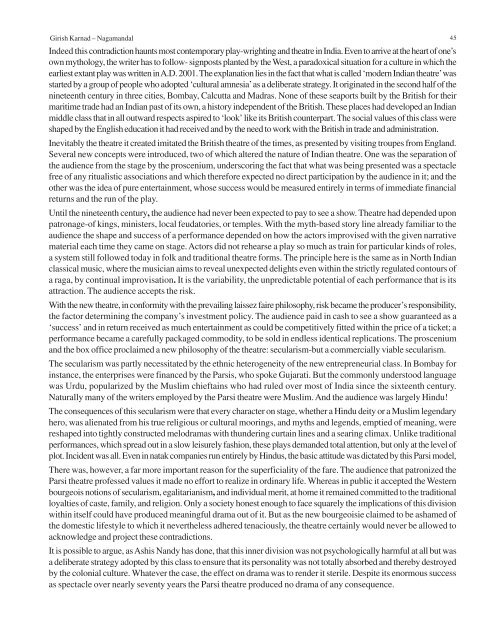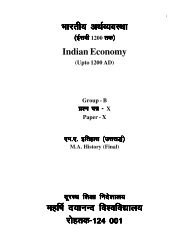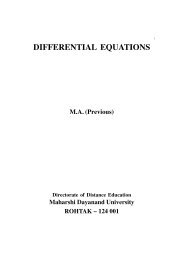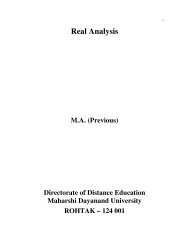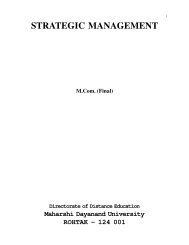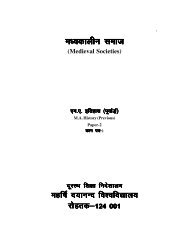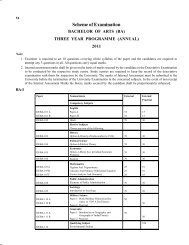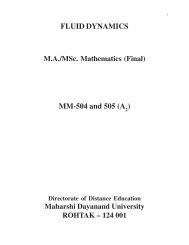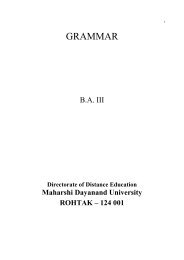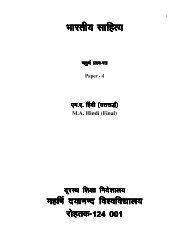LITERATURE AND GENDER - Maharshi Dayanand University, Rohtak
LITERATURE AND GENDER - Maharshi Dayanand University, Rohtak
LITERATURE AND GENDER - Maharshi Dayanand University, Rohtak
Create successful ePaper yourself
Turn your PDF publications into a flip-book with our unique Google optimized e-Paper software.
Girish Karnad – NagamandalIndeed this contradiction haunts most contemporary play-wrighting and theatre in India. Even to arrive at the heart of one’sown mythology, the writer has to follow- signposts planted by the West, a paradoxical situation for a culture in which theearliest extant play was written in A.D. 2001. The explanation lies in the fact that what is called ‘modern Indian theatre’ wasstarted by a group of people who adopted ‘cultural amnesia’ as a deliberate strategy. It originated in the second half of thenineteenth century in three cities, Bombay, Calcutta and Madras. None of these seaports built by the British for theirmaritime trade had an Indian past of its own, a history independent of the British. These places had developed an Indianmiddle class that in all outward respects aspired to ‘look’ like its British counterpart. The social values of this class wereshaped by the English education it had received and by the need to work with the British in trade and administration.Inevitably the theatre it created imitated the British theatre of the times, as presented by visiting troupes from England.Several new concepts were introduced, two of which altered the nature of Indian theatre. One was the separation ofthe audience from the stage by the proscenium, underscoring the fact that what was being presented was a spectaclefree of any ritualistic associations and which therefore expected no direct participation by the audience in it; and theother was the idea of pure entertainment, whose success would be measured entirely in terms of immediate financialreturns and the run of the play.Until the nineteenth century, the audience had never been expected to pay to see a show. Theatre had depended uponpatronage-of kings, ministers, local feudatories, or temples. With the myth-based story line already familiar to theaudience the shape and success of a performance depended on how the actors improvised with the given narrativematerial each time they came on stage. Actors did not rehearse a play so much as train for particular kinds of roles,a system still followed today in folk and traditional theatre forms. The principle here is the same as in North Indianclassical music, where the musician aims to reveal unexpected delights even within the strictly regulated contours ofa raga, by continual improvisation. It is the variability, the unpredictable potential of each performance that is itsattraction. The audience accepts the risk.With the new theatre, in conformity with the prevailing laissez faire philosophy, risk became the producer’s responsibility,the factor determining the company’s investment policy. The audience paid in cash to see a show guaranteed as a‘success’ and in return received as much entertainment as could be competitively fitted within the price of a ticket; aperformance became a carefully packaged commodity, to be sold in endless identical replications. The prosceniumand the box office proclaimed a new philosophy of the theatre: secularism-but a commercially viable secularism.The secularism was partly necessitated by the ethnic heterogeneity of the new entrepreneurial class. In Bombay forinstance, the enterprises were financed by the Parsis, who spoke Gujarati. But the commonly understood languagewas Urdu, popularized by the Muslim chieftains who had ruled over most of India since the sixteenth century.Naturally many of the writers employed by the Parsi theatre were Muslim. And the audience was largely Hindu!The consequences of this secularism were that every character on stage, whether a Hindu deity or a Muslim legendaryhero, was alienated from his true religious or cultural moorings, and myths and legends, emptied of meaning, werereshaped into tightly constructed melodramas with thundering curtain lines and a searing climax. Unlike traditionalperformances, which spread out in a slow leisurely fashion, these plays demanded total attention, but only at the level ofplot. Incident was all. Even in natak companies run entirely by Hindus, the basic attitude was dictated by this Parsi model,There was, however, a far more important reason for the superficiality of the fare. The audience that patronized theParsi theatre professed values it made no effort to realize in ordinary life. Whereas in public it accepted the Westernbourgeois notions of secularism, egalitarianism, and individual merit, at home it remained committed to the traditionalloyalties of caste, family, and religion. Only a society honest enough to face squarely the implications of this divisionwithin itself could have produced meaningful drama out of it. But as the new bourgeoisie claimed to be ashamed ofthe domestic lifestyle to which it nevertheless adhered tenaciously, the theatre certainly would never be allowed toacknowledge and project these contradictions.It is possible to argue, as Ashis Nandy has done, that this inner division was not psychologically harmful at all but wasa deliberate strategy adopted by this class to ensure that its personality was not totally absorbed and thereby destroyedby the colonial culture. Whatever the case, the effect on drama was to render it sterile. Despite its enormous successas spectacle over nearly seventy years the Parsi theatre produced no drama of any consequence.45


